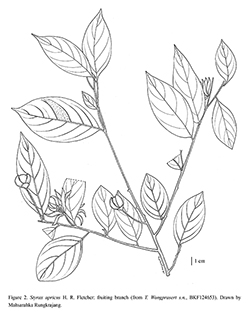e-Flora of Thailand
Volume 14 > Part 2 > Year 2019 > Page 344 > Styracaceae > Styrax
1. Styrax apricus H.R.Fletcherwfo-0000492259
Bull. Misc. Inform. Kew 1937: 508. 1937; in Craib, Fl. Siam Enum. 2: 391. 1938. Fig. 2.
Accepted Name : This is currently accepted.
Description : Shrubs to trees, to 15 m high, dbh to 19 cm; branchlets hirsute, glabrescent, bark not stripping to somewhat stripping. Outer bark thin (to thickened), smooth to slightly fissured to cracked, light to dark brown to dark grey; inner bark dark red; wood white. Indumentum of simple and stellate hairs, short (ca 0.2 mm long) and long (ca 0.5 mm long), latter in inflorescences and young leaves. Leaves: petioles 6–9 mm long, reniform to V-shaped in transverse section, longitudinally ridged when dry, hirsute, somewhat pulvinate; blades ovate to almost elliptic, 4.6–17 by 2.4–7.5 cm, pergamentaceous, base cuneate, margin entire, flat to somewhat revolute, apex acute to cuspidate, upper surface glabrous except for base and basal part of the midrib, young leaves quickly shed off indument, but not completely before maturity, lower surface densely hairy, with long hairs when young, older ones often with shorter hairs mainly, epidermis not visible, silvery to white underneath; venation slightly raised above and more so beneath, above midrib and major veins slightly depressed, secondary nerves 7–9, tertiary veins rather scalariform, especially visible underneath; highest order veins densely reticulate, visible above. Inflorescences racemose to paniculate thyrses, to 10.5 cm long, hirsute; bracts inrolled, appearing subulate, to 2.5–4.5 mm long, hirsute. Flowers 14–15.2 mm diameter; pedicels 2–4.5 mm long, hirsute. Calyx tube 3.5–4 by 3.8–4 mm; teeth triangular, ca 0.8 by 1.8–2 mm. Corolla 11–14.5 mm long; tube ca 2.5 mm high; lobes long ovate to oblong, 8–11.5 by 1.8–3, valvate, inrolled, inside few hairs, especially apically. Stamens: filament tube ca 3 mm high, free part of filaments 2.5–3 mm long, gradually somewhat narrowing towards apex, completely hairy; anthers 3.2–3.8 mm long. Ovary ovoid, 1.2–2 mm wide; style 8–8.5 mm long; stigma lobes yellowish. Fruits flattened globose, 10–14 by 12–15 mm, apiculate apically, dehiscent into 3 valves, smooth, not wrinkled, apically apiculate when immature, green to whitish; wall 1–1.5 mm thick, woody, brown when dry; calyx remaining attached to fruit, saucer-shaped. Seeds flattened globose, 7–9 by 8–11 mm, smooth, apically slightly pointed, with 3 slightly raised longitudinal ridges.
Thailand : NORTHERN: Chiang Mai (Doi Angkhang, Doi Kio Torn, Doi Luang, Doi Suthep, Fang, Mae Taeng, Om Koi), Chiang Rai (Phu Langka), Lamphun (Khun Tan), Tak (Khun Phra Wo, Taksin Maharat), Phitsanulok (Phu Hin Rong Kla); NORTH-EASTERN: Phetchabun (Lom Kao, Lom Sak), Loei (Dan Sai, Huai Nam Man – type: Kerr 5810, isotype -BK; Na Haew, Phu Kradueng, Phu Luang, Phu Ruea, Phu Suan Sai, Phu Tong, Wang Saphung); EASTERN: Chaiyaphum (Phu Khiao); SOUTH-WESTERN: Kanchanaburi (Pha Takanun, Thung Yai Naresuan), Phetchaburi (Kaeng Krachan).
Distribution : Said to be endemic to Thailand, but likely to be also present in Myanmar and Laos.
Ecology : Found in various types of forests: dry evergreen forests, hill evergreen forests, mixed deciduous forests, pine-oak dipterocarp forests, disturbed secondary growths, open grassy spots in pine-forests to savannas, on forestsed cliffs, by streams; bedrock granite, limestone, phyllite or sandstone; 600–1,750 m alt. Flowering: March–August, November; fruiting: February, April (old fruit), July–December.
Vernacular : Kam yan (กำยาน); kam yan bai yai (กำยานใบใหญ่)(Northeastern); nam man kop (น้ำมันกบ), ton kop (ต้นกบ)(Loei); salot (สลอด)(Chiang Rai, Loei); tam yan (ตำยาน); ton khun (ต้นขุ่น)(Chiang Mai).
Uses: Some benzoin in old wood.
Notes: 1. The species concept between Styrax apricus, S. benzoides, and S. benzoin is far from satisfying. In comparison to the other species, the differences are rather at varietal than species level. The flowers of the three species are similar. Styrax apricus has long hairs, the other two generally shorter, this gives a difference in touch, the leaves of S. apricus feel velvety (softer) then those of the other two (more silky). Styrax apricus and S. benzoin retain hairs on the upper leaf surface longer than S. benzoides. Finally, S. benzoin has indehiscent fruits, those of the other two are dehiscent; the fruits of S. benzoin are larger, especially in the Peninsular part, the wall thicker and somewhat wrinkled, while the calyx becomes separate from the fruit and flattens to recurves (closely stuck to the fruit in the other two species). There are some slight differences in the galls, all have banana-like galls, which are transformed petals and stamens, yellow to dark orange outside, pale light green inside. Those of S. benzoin may be larger than of the other two species, while S. apricus may also have galled fruits (not seen in the other two species). Especially, in the area of overlap (Chiang Mai, Chiang Rai) the differences between the three species often become questionable.
2. Smitinand (BKF97146) reports simulid flies on the plants that may have caused the galls, but according to the literature only Aphids cause the galls.

